Create a beautiful table runner quilt everyone will love. This easy quilted table runner pattern is perfect for beginners. See why!
Of all the quilting patterns for table runners, this one turned out to be the easiest for me. So if you're a quilting beginner looking for a first quilted runner pattern for your dining table, or a seasoned quilter searching for a quick, one-afternoon make to use up scraps - you'll both be happy with this one.
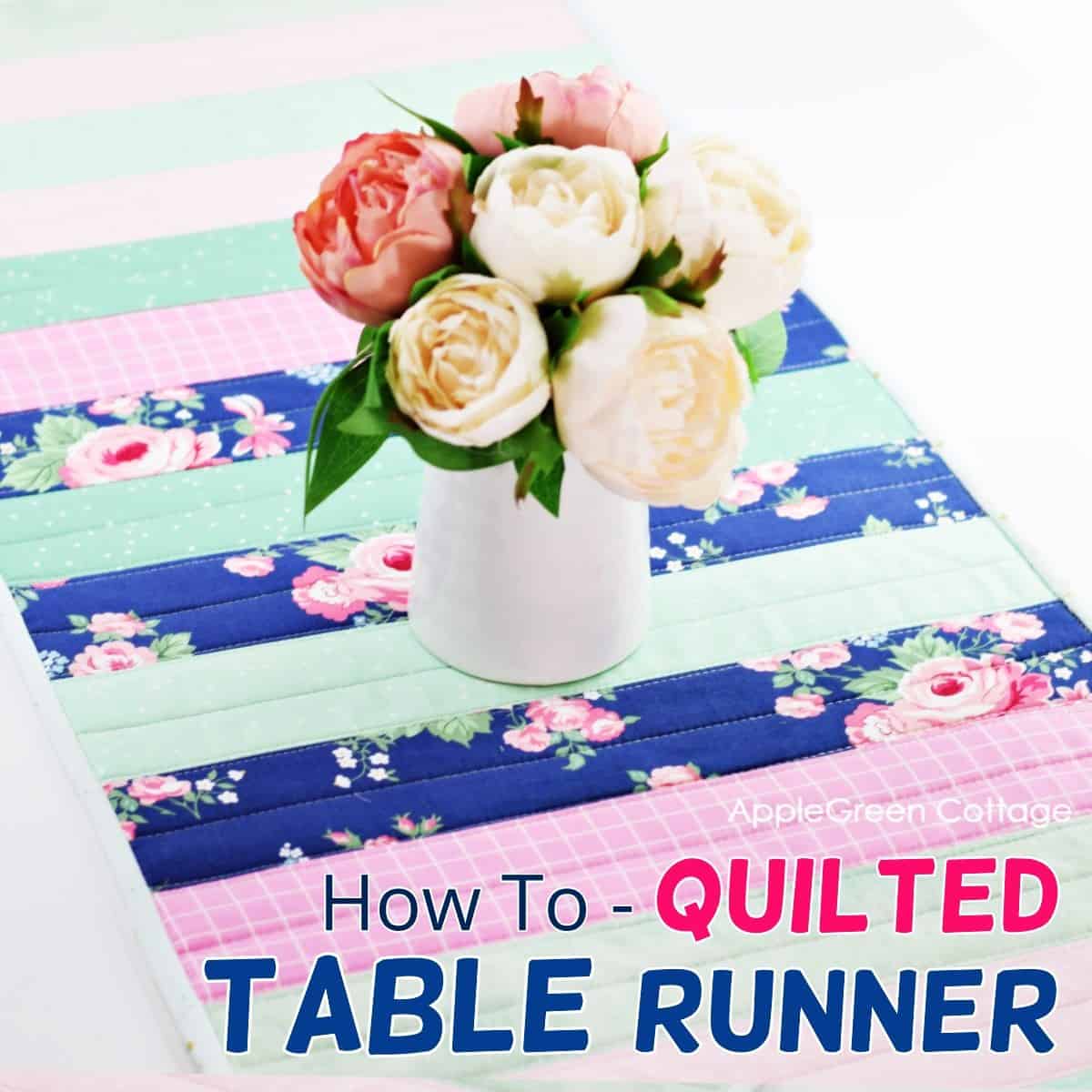
Do you want an ad-free, printable copy of this online tutorial? Find it here for just $3. You won’t need to access the internet every time you want to make it. ------ Or get the BUNDLE with ALL the Printable Tutorials - current and future ones!
This quilt as you go table runner is great for any time of the year. And I'm adding ideas for tons of variations at the end of the tutorial. Scroll down and get inspired!
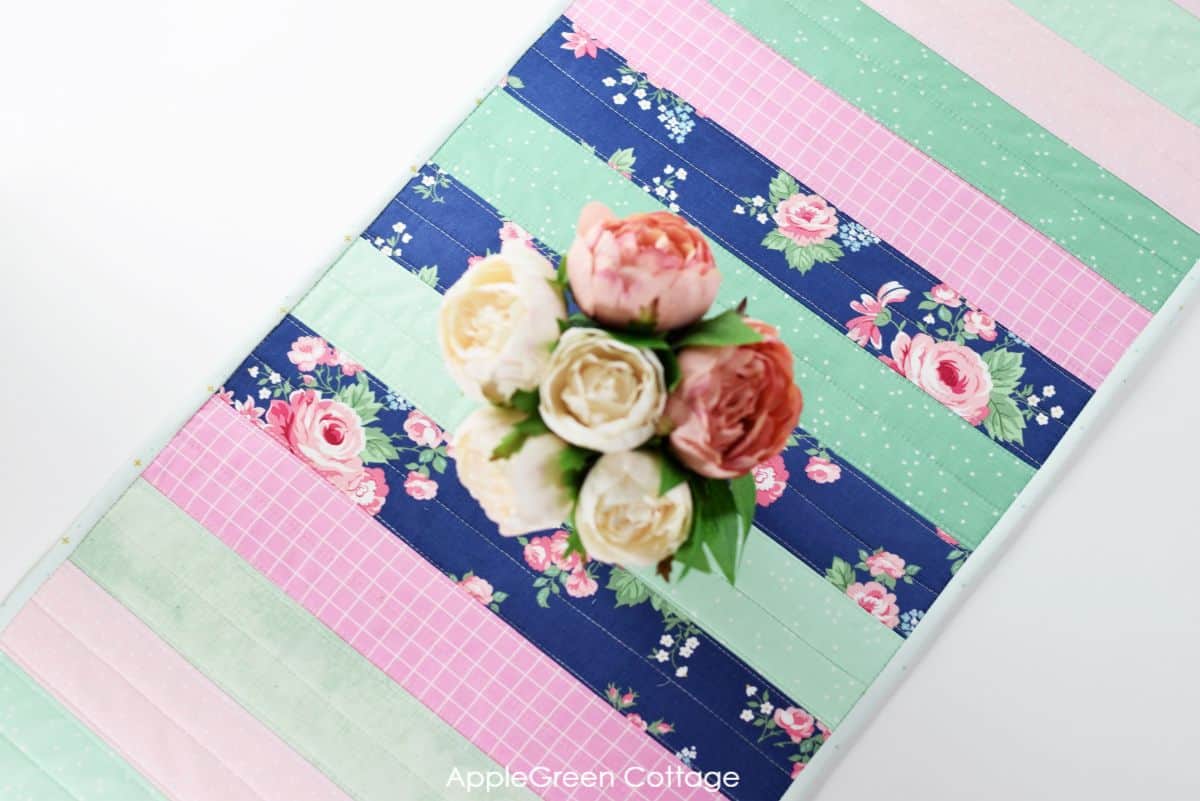
Features
Why you'll love this table runner project:
- simple construction
- uses up scraps
- fat-quarter friendly, saves on yardage
- a beautiful, no-fail, no-fuss home decor project you'll be able to showcase every single day. Get ready for compliments - even if you've never quilted before!
This easy quilted table runner pattern uses up all those scrappy strips of lovely fabric you couldn’t throw out but didn’t know what to do with. You do need half a yard piece for the backing though, but that's the only large piece you'll need in this project. Oh, and before I forget, also check out our new SewPretty HOME email series:
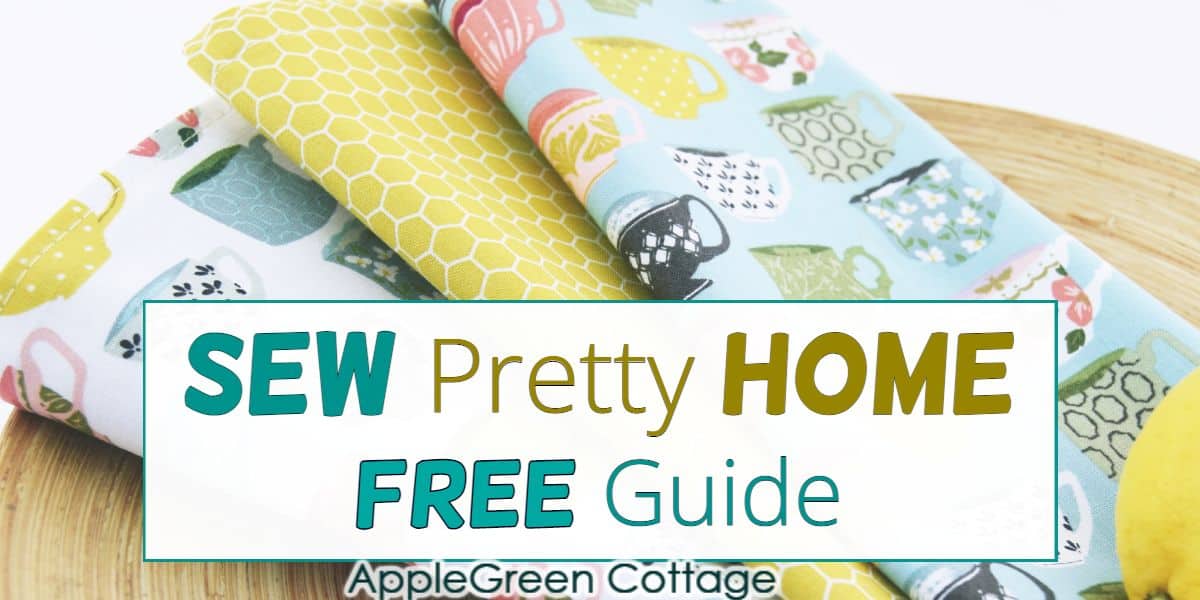
Join the FREE 7-part email course and make 6 beautiful items for your home! You'll love it!
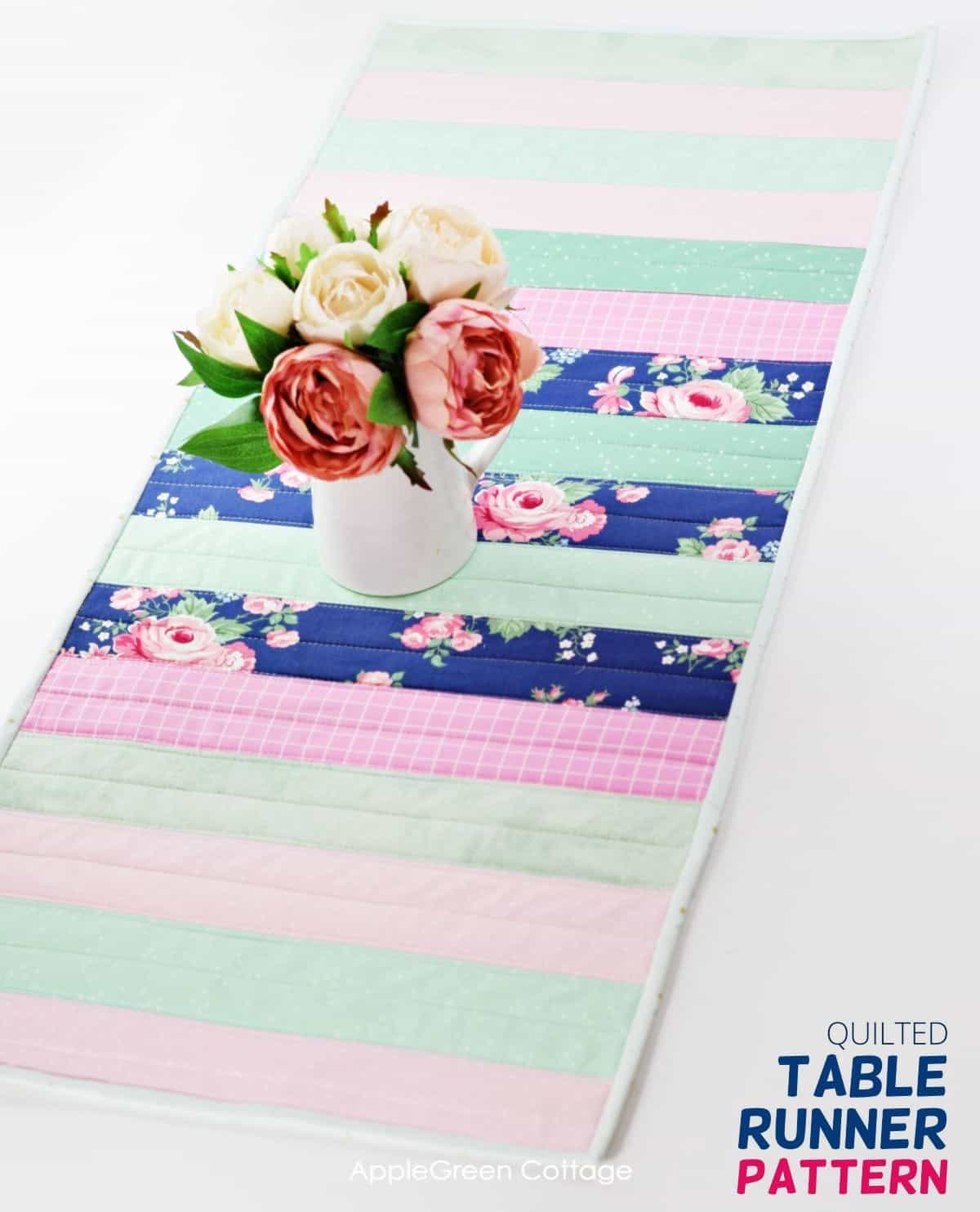
Or, why this is the Easiest Quilt As You Go Table Runner Pattern.
The quilt as you go construction makes this table runner a great beginner quilting project. Basically, this is a quilting technique when you quilt each piece of fabric simultaneously with piecing the quilt. But it's so much easier than it sounds!
See this tutorial to find out everything about what is quilting as you go - and how to use this technique pretty much anywhere. But let's get back to our quilted runner idea.
What is the size of this table runner?
This table runner quilt finishes at 40" by 16" - for more than one reason.
Of course, you can easily expand or decrease the size to fit your exact décor needs. But I chose this particular size for several reasons: first, your backing can be cut on WOF so you don't need to buy extra fabric yardage. And secondly, the width of the quilt-as-you-go table runner is just right to use any fat quarters you might have in your stash.
Quilted Table Runner Tutorial
Step 1 - Fabric Selection
This step is fairly subjective:
- select the fabric pieces in colorways that will work best for your project. (either similar or contrasting, whatever you like best), keeping in mind that one print or color will need to be your focus color.
- you'll then mix and match the center by adding other colors and prints to each side of the focal piece
Or, just pick a few of your favorite colors you want to work with, solids are totally amazing with this quilting technique! This is what I collected:
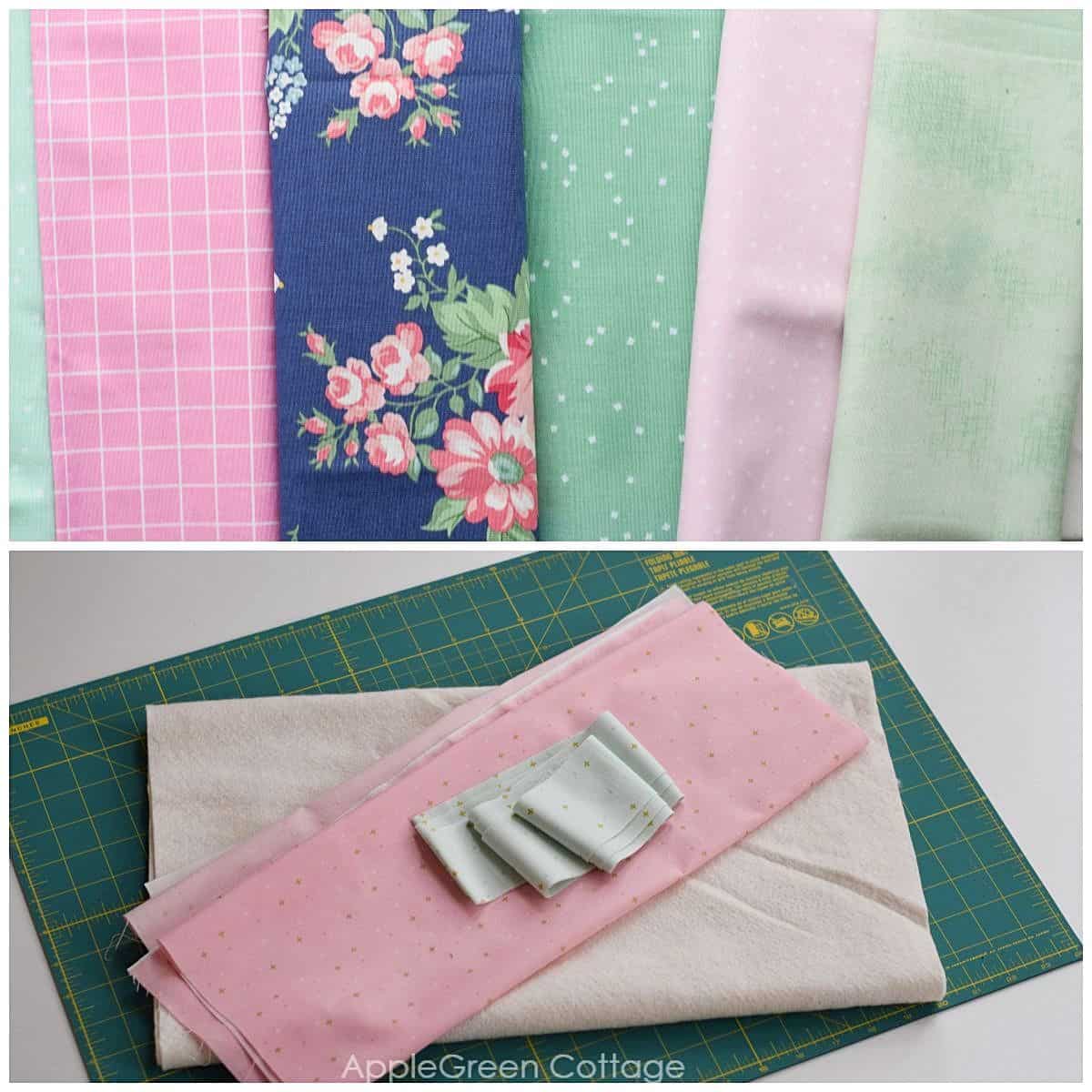
To help you choose your color scheme for the front of your table runner, here's mine: A - navy blue floral (focus print!), B - pink, C - Grass green, D - Mint, E - light green, F - light baby pink
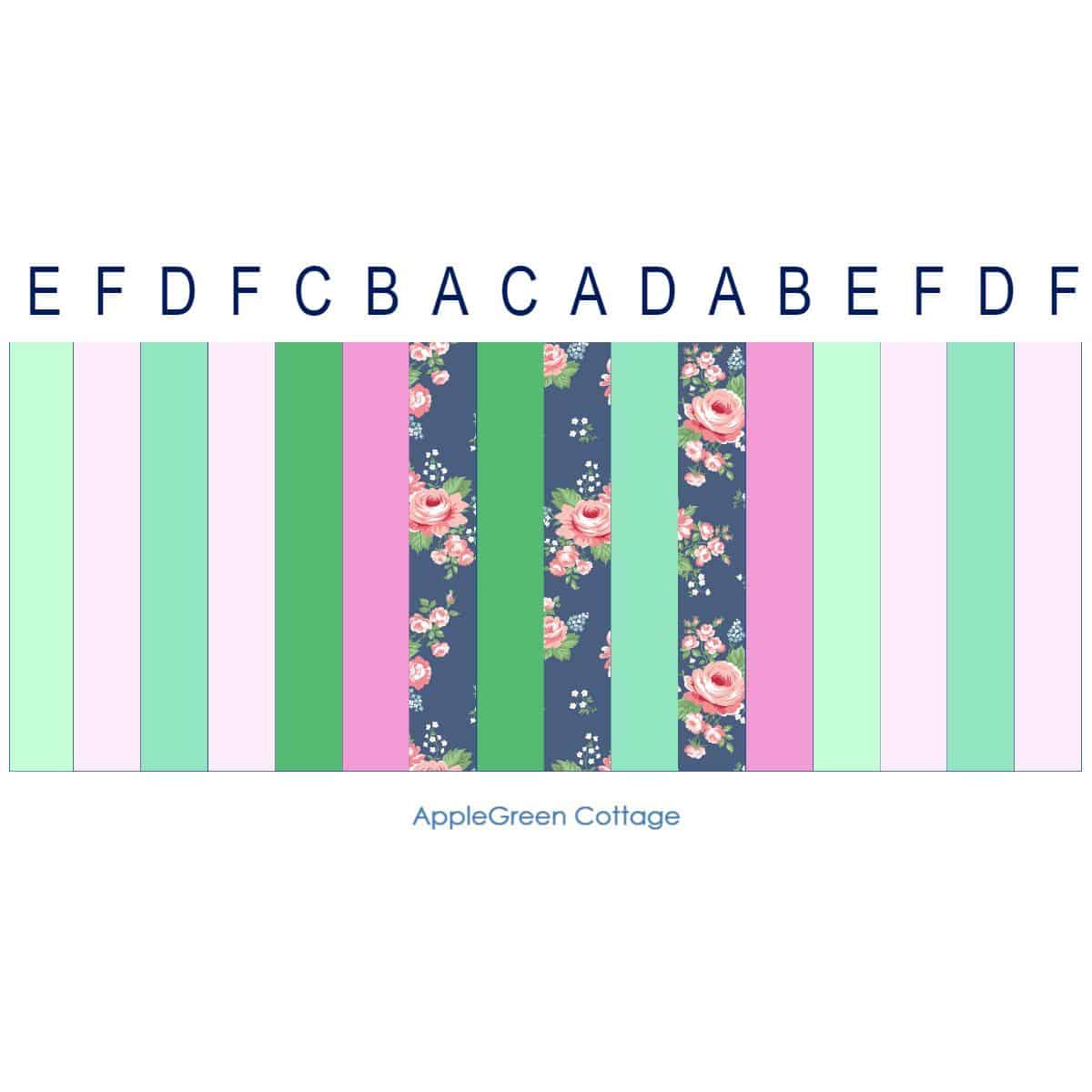
This table runner quilt pattern has no printable template. Simply cut 3" strips, as easy as that!
Step 2 - Cutting Instructions
Then cut: (16) strips of 18" by 3":
- 3 strips in Fabrics A and D
- 2 strips in Fabrics B, C, and E
- 4 strips in Fabric F
Batting and backing: cut a piece of 43" by 19" from the backing fabric and from batting, respectively. If your fabric has at least a 43" width, you can cut on WOF - and save on yardage. That's what I do.
Binding: you'll need to cut 3 stripes from the width-of-fabric and sew it together to get approximately 130" or 3.5 yards of binding.
Step 3 - Prepare batting and backing
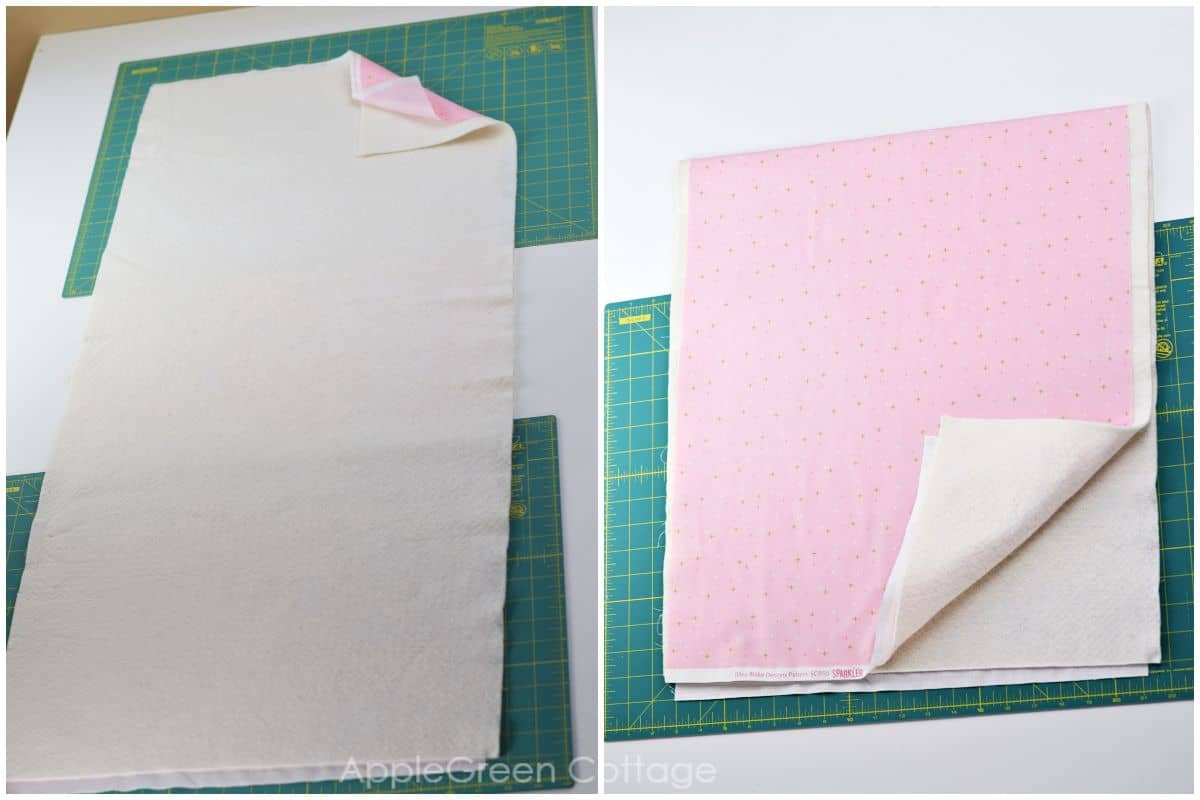
Place your backing fabric on a flat surface, right side facing down. Press it so it's completely flat and without puckers. Then place the batting over it, it should be approximately the same size. I use a basting spray (one like Odif 505) to keep the two layers together.
Fold in half and mark the center line on bating.
Step 4 - Arrange Fabric Pieces
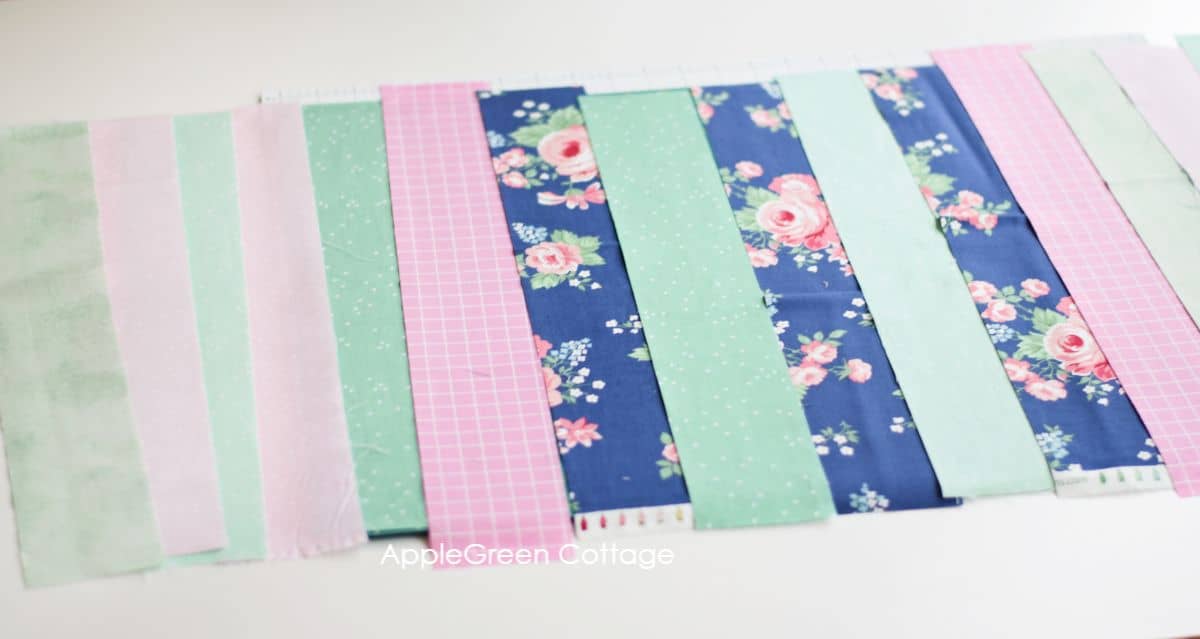
Step 5 - Stack Pieces in order
Stack the strips in order they you placed them in the previous step. Make two piles: one for the right side of the table runner, and one for the left side of the runner:
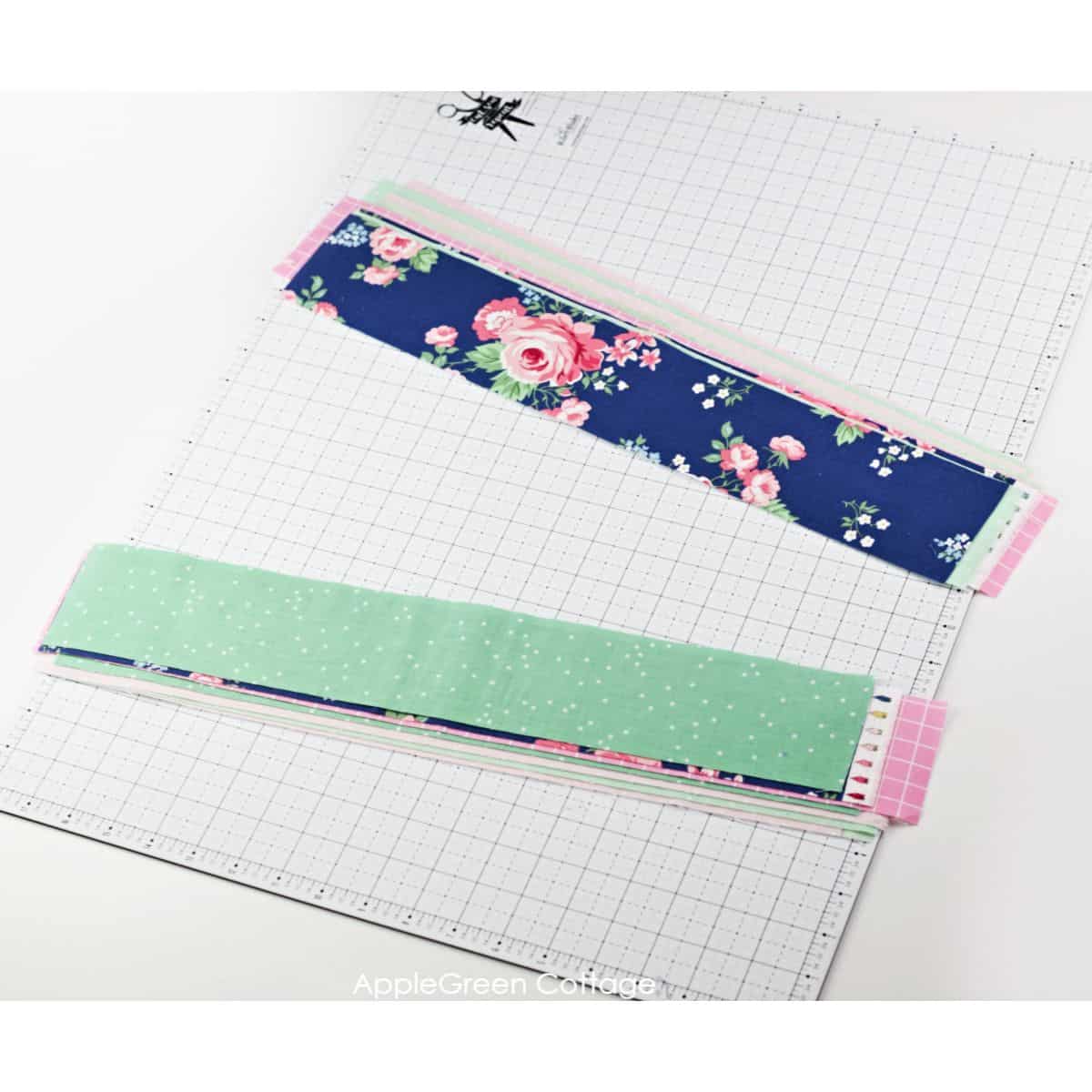
Keep the strips and piles in order - the furthest from the center will be at the bottom, and the center two strips will be on top of each stack, see image above.
Step 6 - Attach The Central 2 Pieces
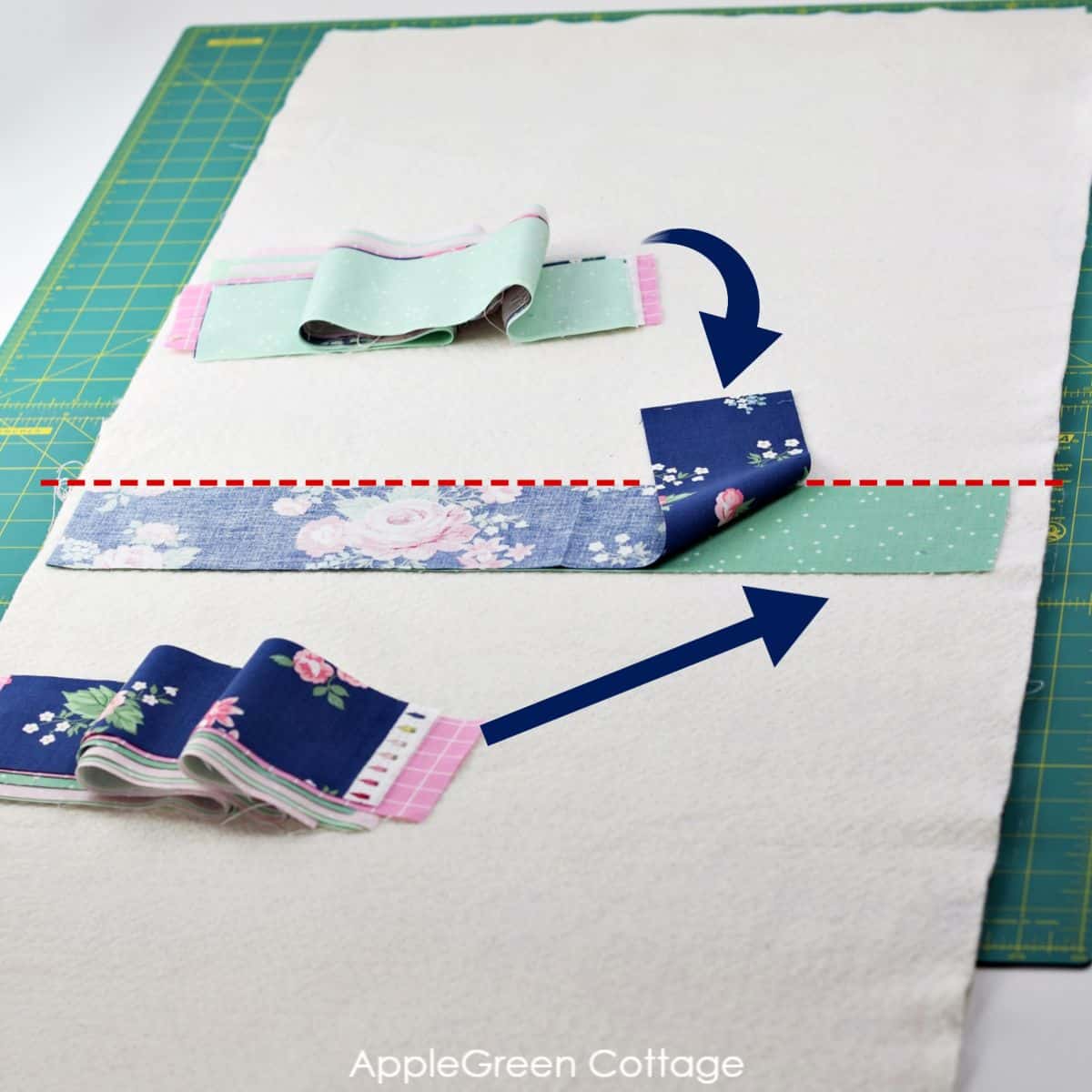
We'll start in the center to minimize shifting. Remember, you are working with 16 strips, but you want to start in the middle with the central 2 pieces (one of them is the focal piece). This is how:
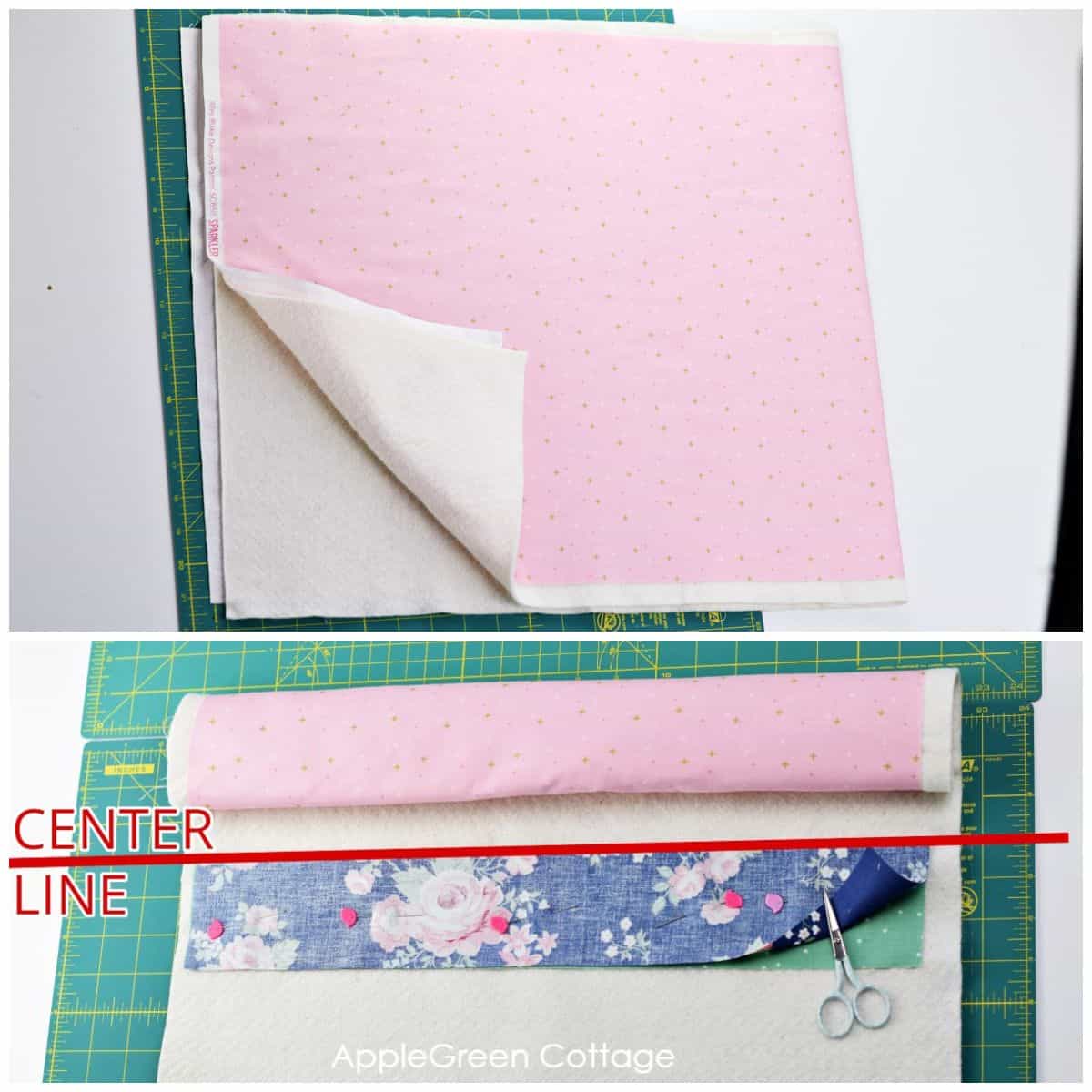
- You've already folded the batting piece in half and mark the crease spot.
- Take one strip from the left stack and place it to one side (here: left) of the central crease, face-up.
- Take one strip from the right stack and place the second strip face-down (so the right sides of strips face each other) with all edges aligned and pin through all layers.
- Sew along the right edge of the fabric using a ¼" seam allowance (6 mm)
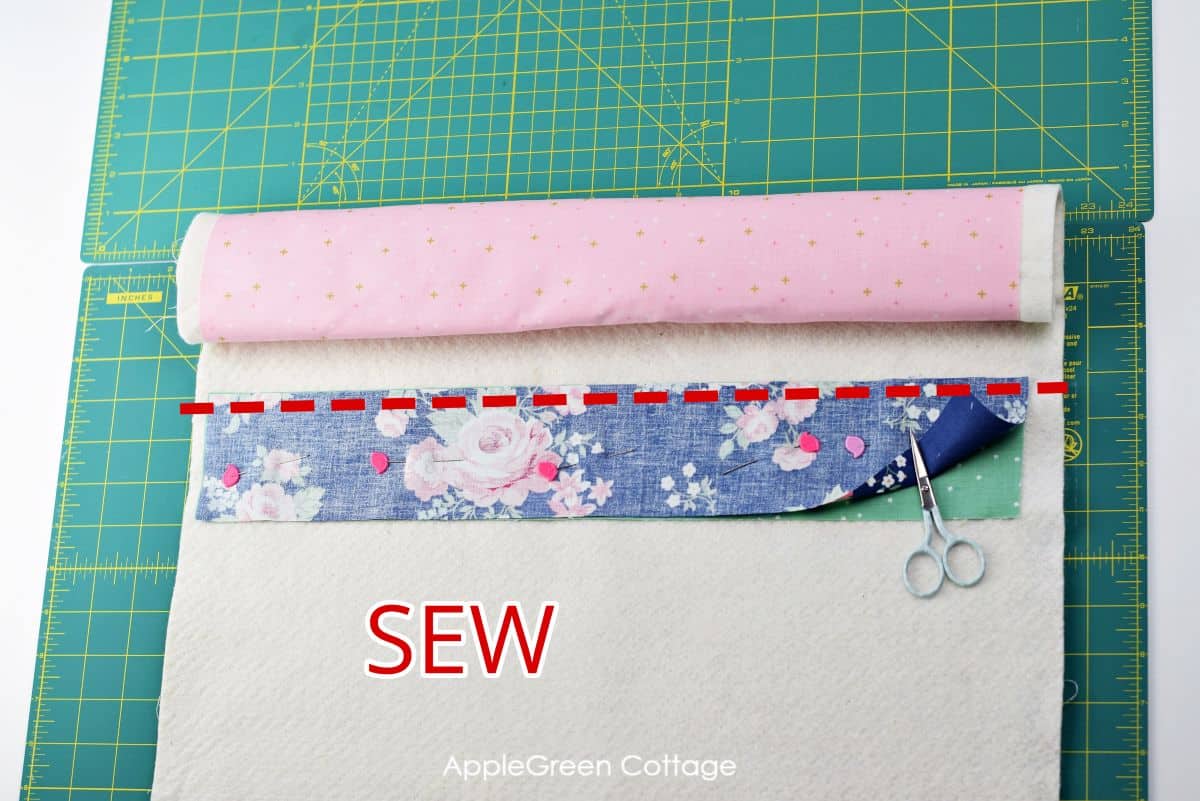
Tip: It is helpful to roll the excess batting/backing from the right side, making it easier to fit into your machine.
Open the pieces and press well. Topstitch on both sides of the seam:
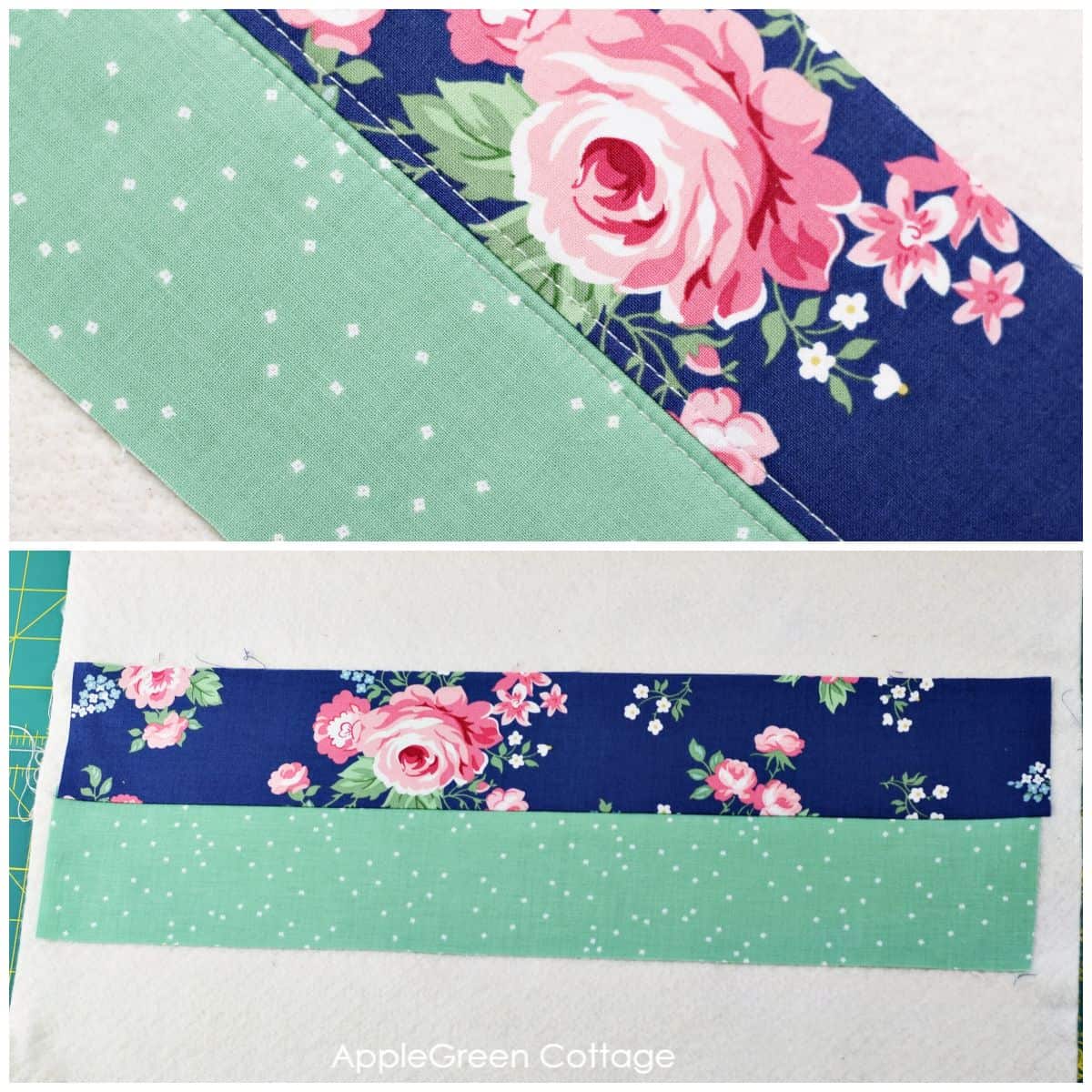
Step 7 - Attach Strips to the right
Now we'll add all the remaining pieces from the right-hand stack the same way:
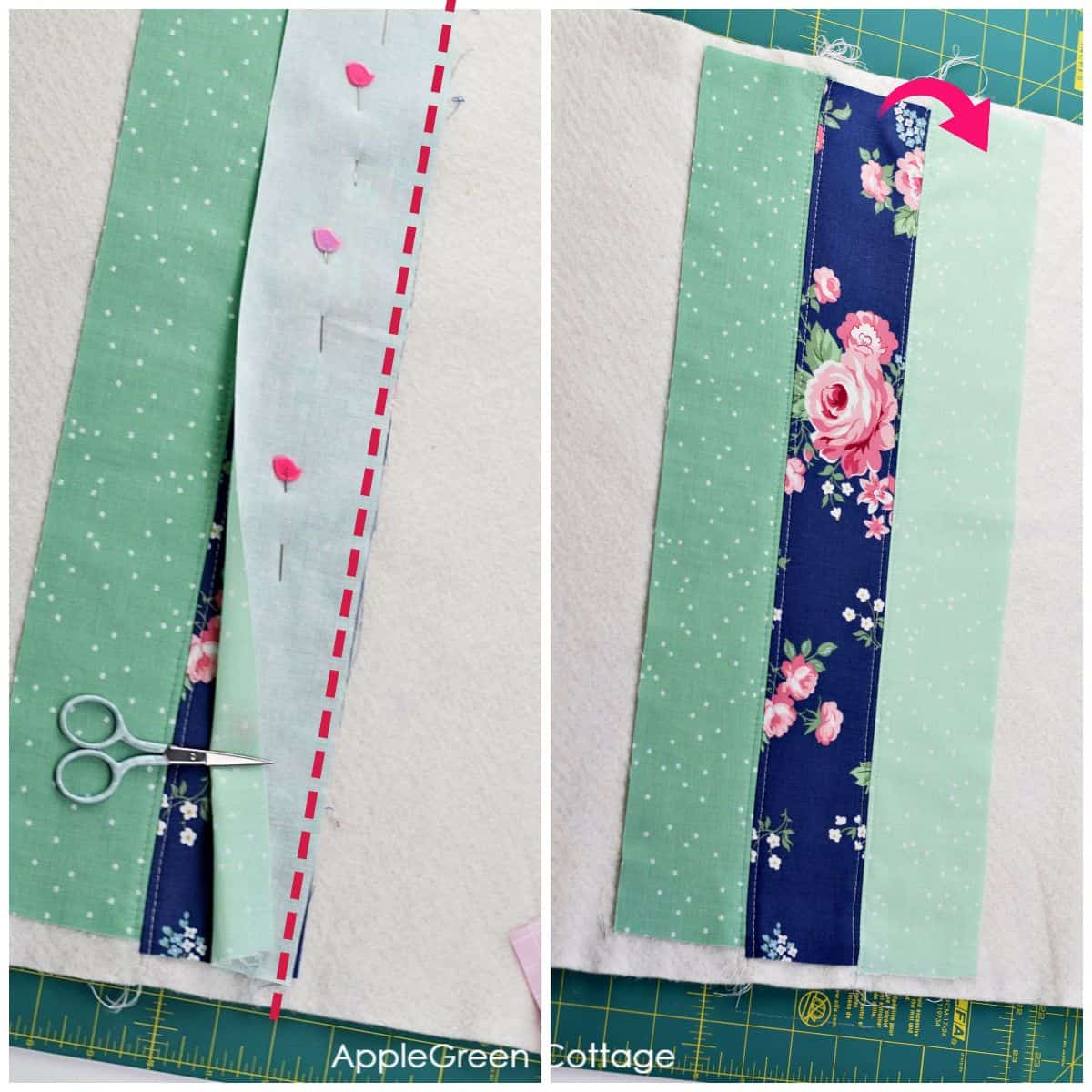
place the next strip from the 'right-side' pile on the previous piece with right sides together, pin, and stitch along the right edge using the ¼" seam allowance. Open and press.
Pin, sew and press after each strip is added, until you've used up all the strips and reached the edge of the batting.
Step 8 - Attach strips on the left
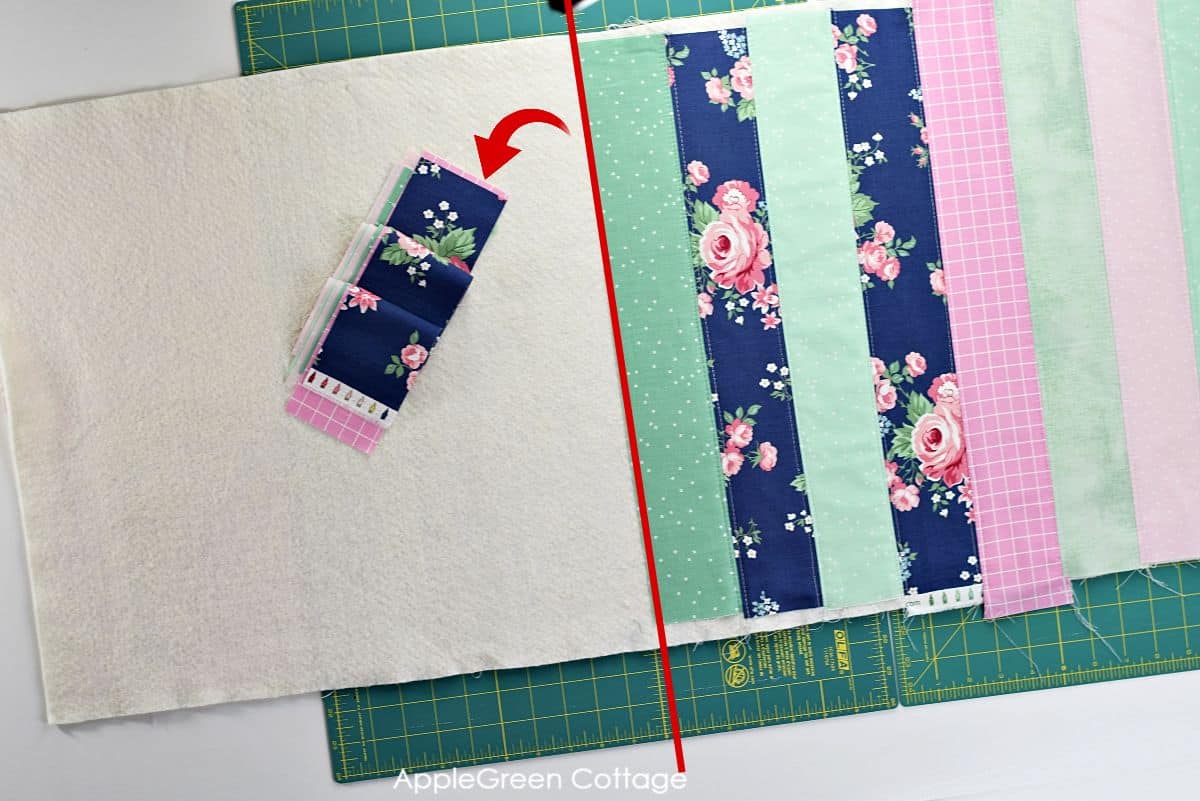
Once you've sewn all the strips from the right-hand pile, do the same with the left-hand pile. Don't forget to press each time.
Step 9 - Optinal - quilting lines
If you want to, you can add some more quilting. I always do.
Step 10 - Square it up
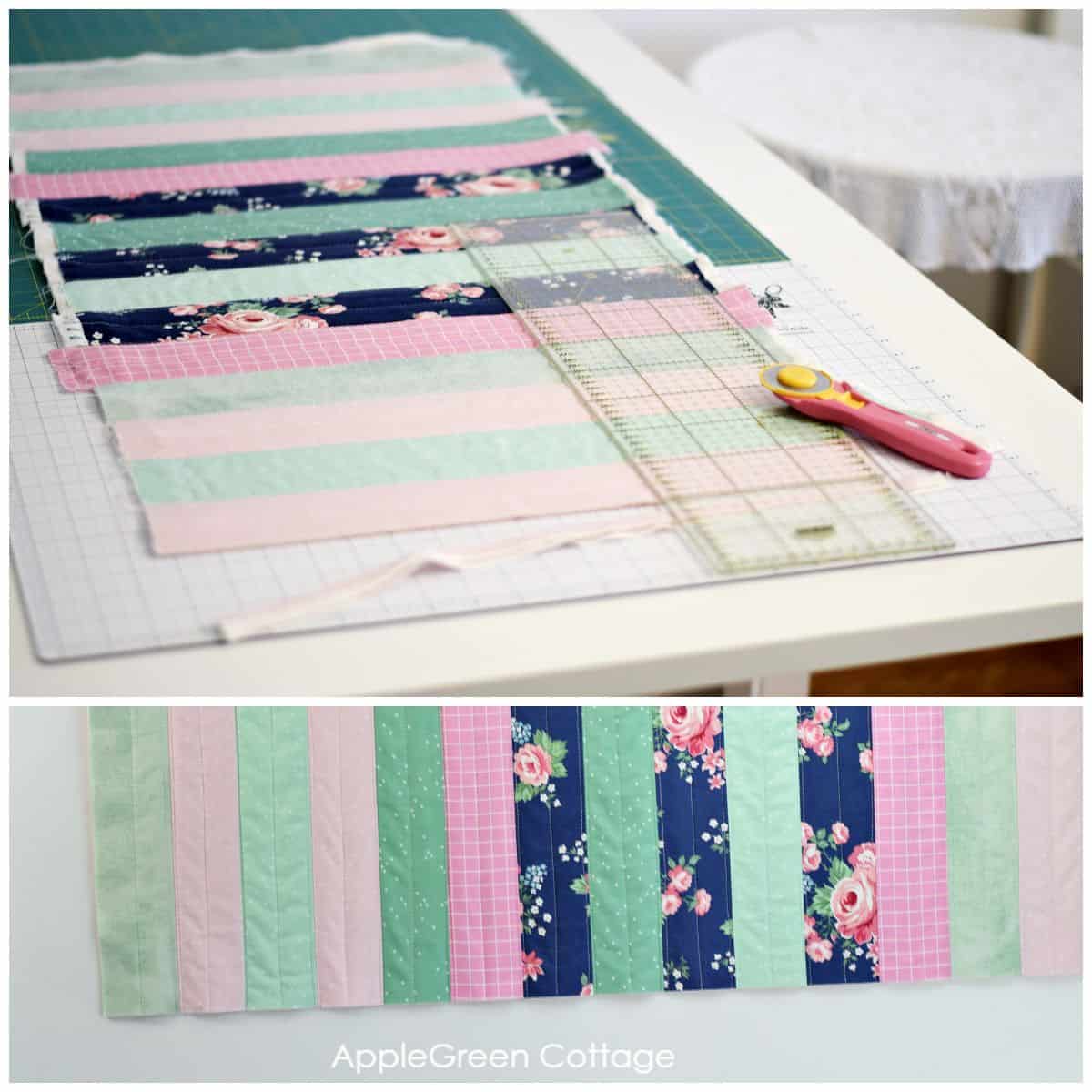
After sewing all the strips for your table runner top, use a quilting ruler and a rotary cutter to cut off any excess fabric, batting and backing, to get all corners to 90 degrees.
Step 11 - Add Binding to Quilted Runner
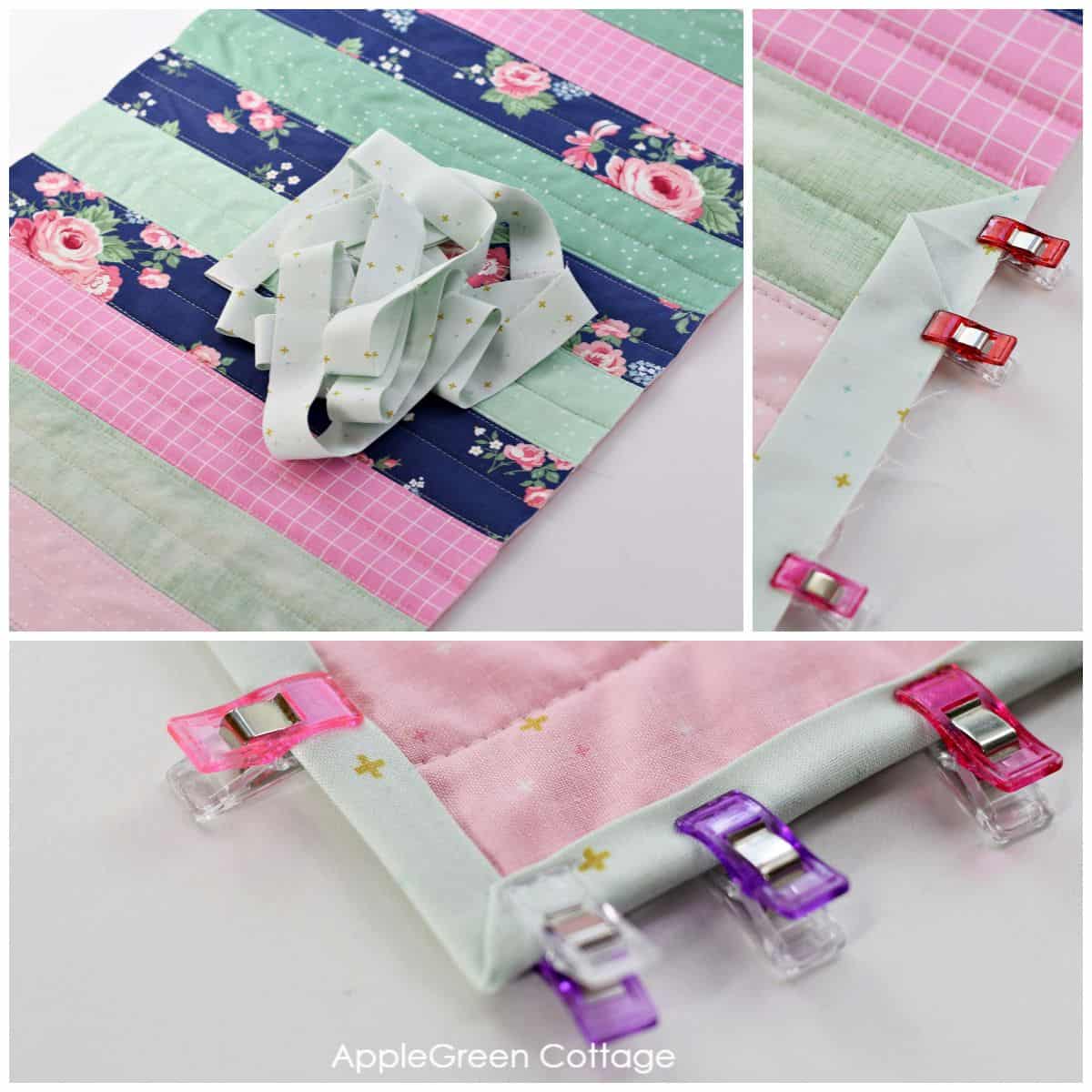
First, take your 130" long strip of binding and press in half if you haven't yet. Attach binding. If you're entirely new to quilt binding, check out my easy quilt binding tutorial - I show you how to machine bind your quilt, and where to start (and why).
It can be easier for you to start attaching the binding at the back of the table runner. Here I started machine binding on the front side of my runner quilt. Plus, use this clever binding hack!
HOW TO START SEWING BINDING AT THE FRONT
Since some of you will definitely want to try this way of applying quilt binding, let me show you quickly how to do it if you start at the front of your quilt sandwich:
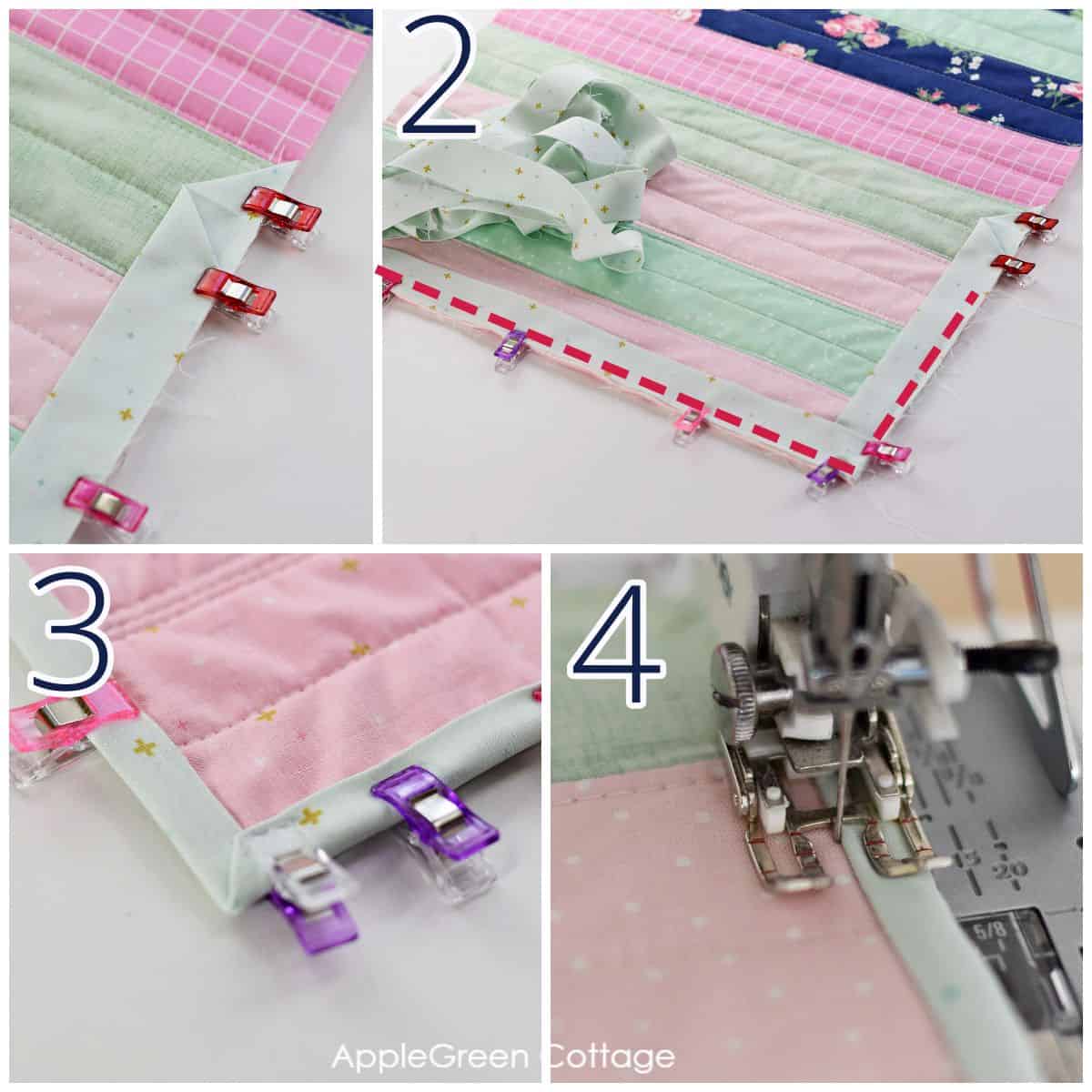
- First, get your binding ready.
- Start attaching binding on the front. (see image 2)
- Then fold it backwards (see image 3) and
- ... finish by machine stitching it in place from the front (see image 4). I did that by stitching in the ditch, and keeping an eye on the back to make sure I caught every layer.
This is what I also did on my panel quilt tutorial. It took me some more time to bind but it turned out beautiful!
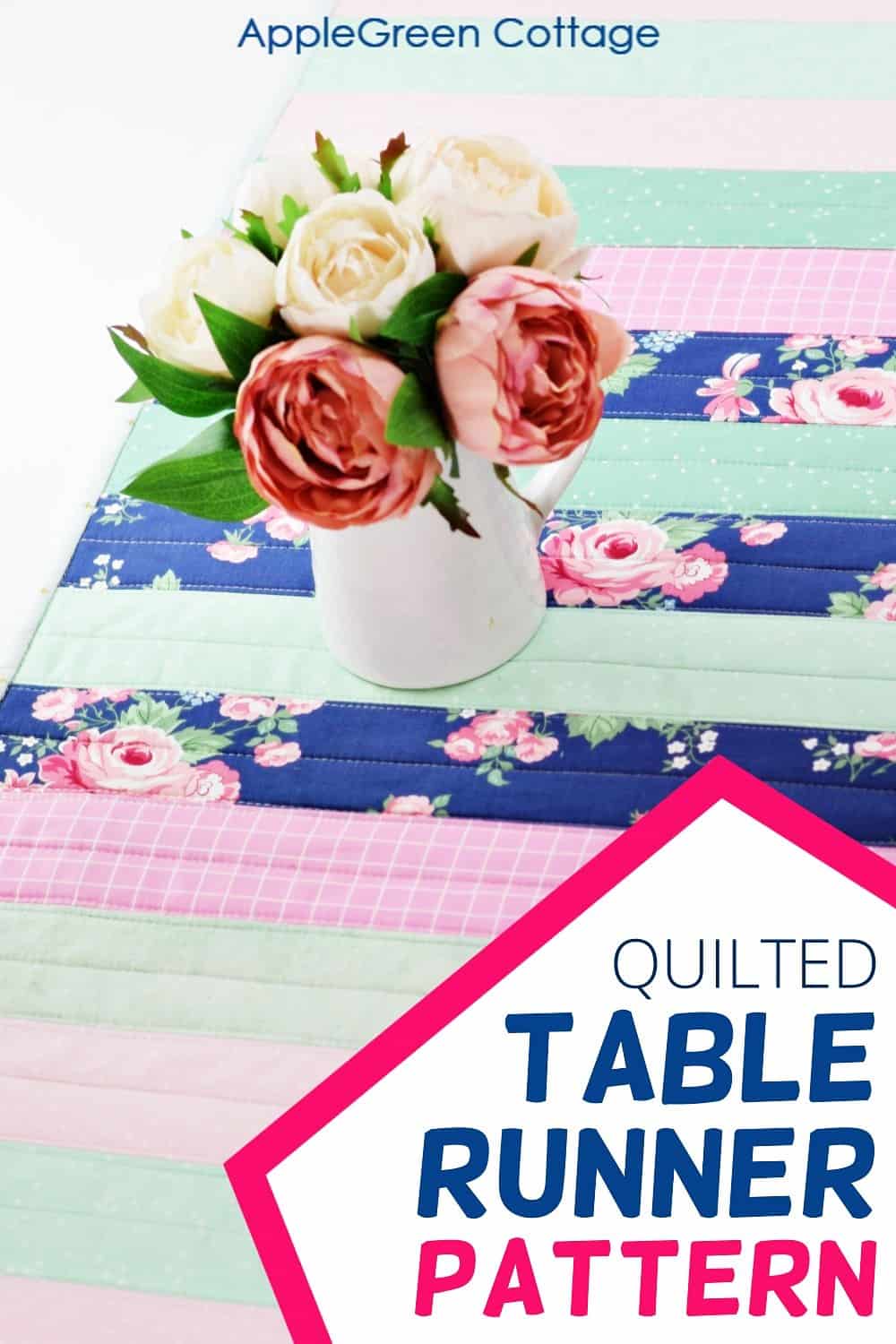
Here I'll also answer a few questions from our readers:
HOW DO YOU CALCULATE QUILT BINDING? LENGTH OF QUILT BINDING.
When you want to figure out how much binding you need for a quilt, you'll need the exact measurements of your squared-up, unfinished quilt. You'll need at least 10 inches more than the perimeter of the table runner project you're working on.
As an example, your quilt is 20" by 30", then 20+30+20+30 =100" when we go around all corners of your quilt. Then add 10" to make sure you don't run out of your binding and to make sure the ends overlap.
Should I use batting to sew a table runner?
Quilted table runners will definitely have some batting, thin or thick. If you are making a non-quilted table runner, you can use some type of interfacing, batting or stabilizer only if you choose so. Pro batting: you can use your diy table as a giant hotpad: And make sure to use the thickest batting you have at hand, as it can double as a giant hot pad - no more worries about placing separate hotpads when serving all that yummy food!
On the other hand, if you choose to use no batting at all (especially handy when sewing this reversible table runner!) the sewing is quicker, and your finished projects takes so little space when folded in your closet. Check out this non-quilted, reversible table runner tutorial if you're looking for one like this.
Why is my backing a bit wrinkled?
Truth, and full disclosure: when using quilt as you go technique, the back of my quilts never look as clean and straight as the front. No problem, that's all ok. The back of the table runner will have more wrinkles than the front, and I like it that way. See for yourself:
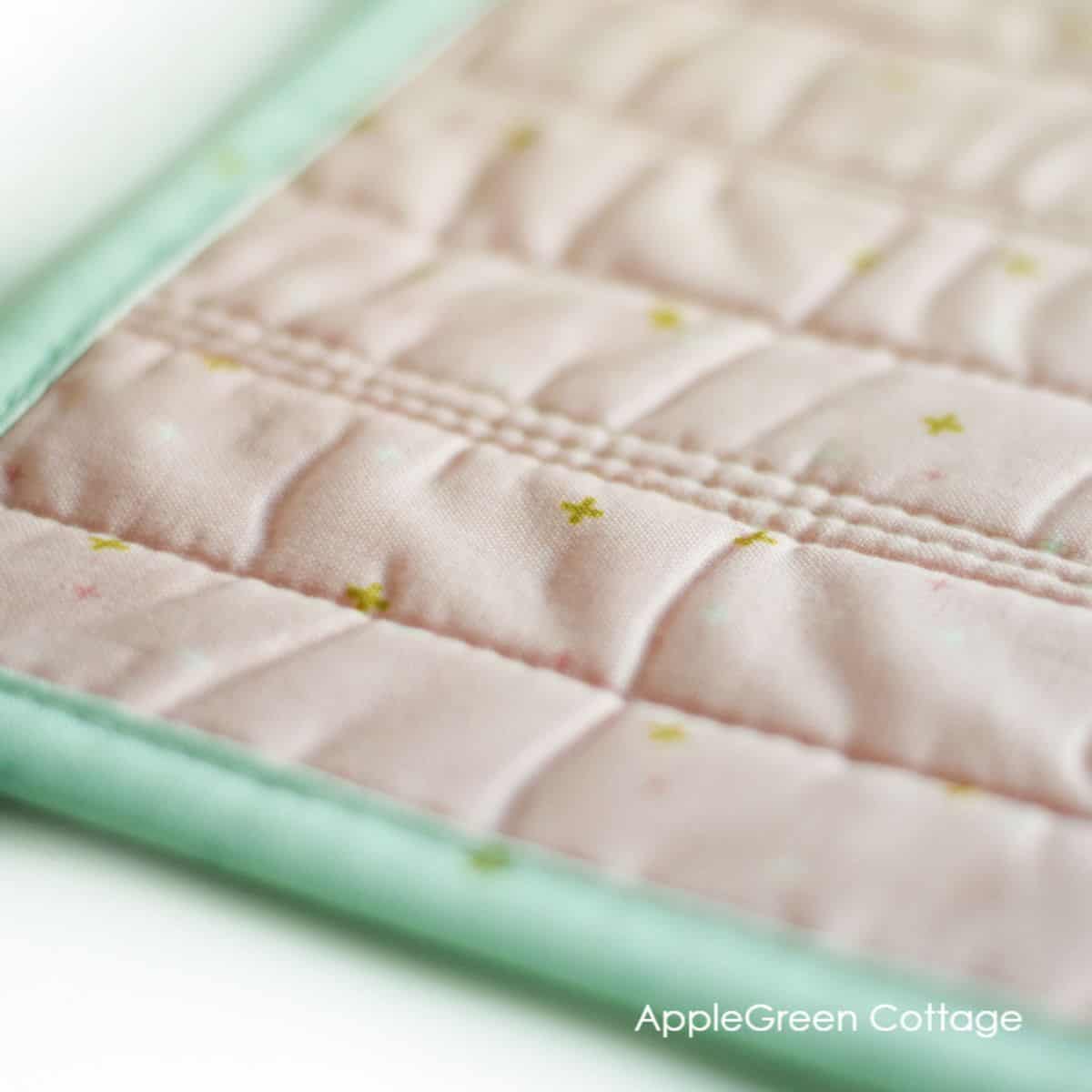
To prevent puckers, however, and help get it as straight as possible, first press the backing, then spray-baste it to the batting (I use Odif 505). and then when you start adding strips to the front and quilting it, use pins to keep the layers as straight as possible. That's all, and yes you want it to look like handmade. It's a feature, not a flaw.
Tips on selecting fabric for a table runner quilt
Choose the focal print/color: something with a stronger visual effect than the rest of your prints/colors. This will be the central and focus color of your quilt as you go table runner. - I chose to go with 3 strips of this beautiful print.
Arrange the pieces for the top layer around these 3 focus strips - in the order you want them to appear on your quilt. I wanted stronger effect towards the center, and lighter hues towards each end.
Variations of this Quilted Table Runner
Why you'll also love this simple 3"-stack pattern? Because it can have so many TOTALLY different looks, just by rearranging the strips! Just to give you an idea, a few variations in addition to the one I showed you before:
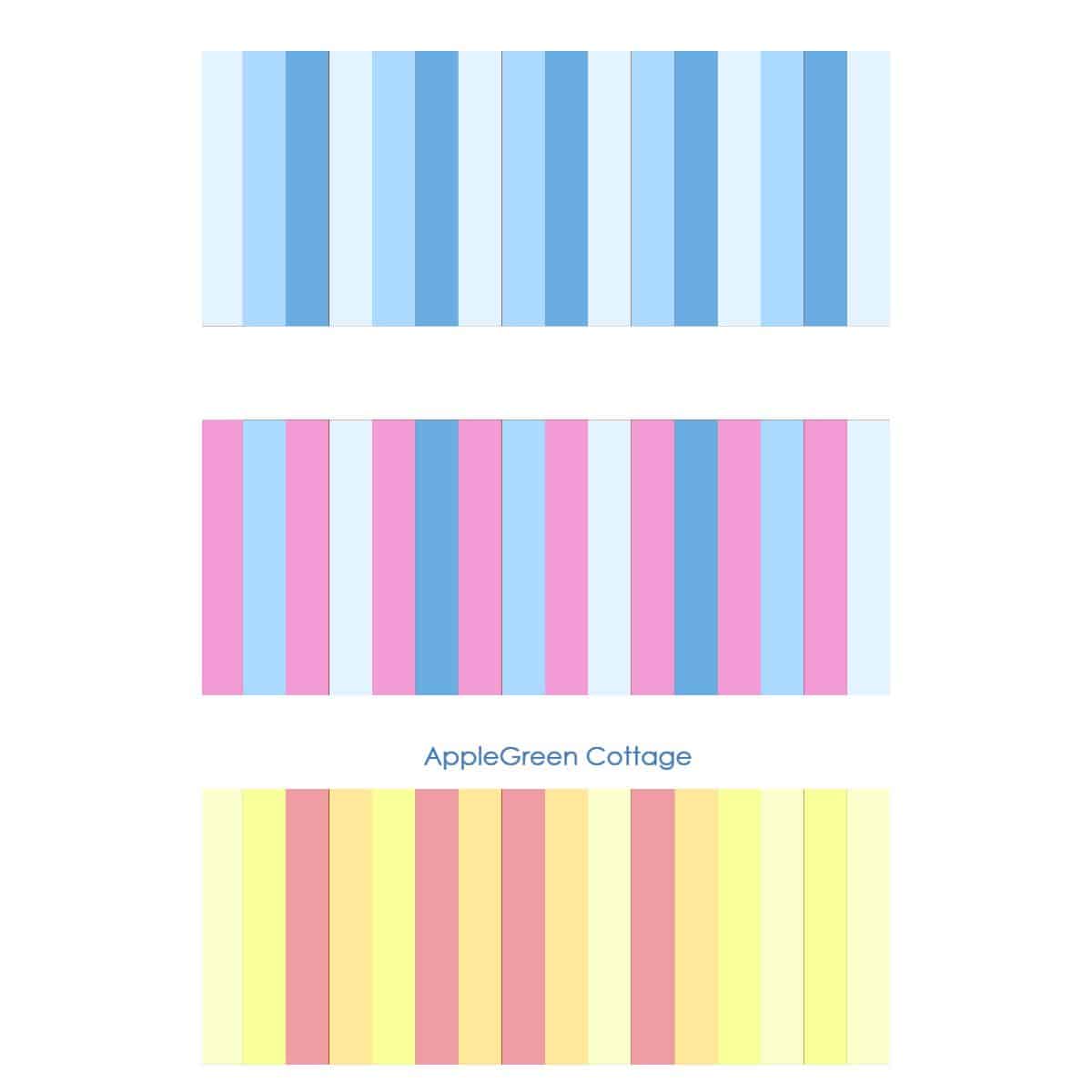
The first one follows the A-B-C pattern with only three different prints, the second one has every second strip identical, and the third one is randomized. Unlimited options, I love that!
And as I write this, there's another table runner in the works: the next one is a Valentines Day table runner I made using this same tutorial. I slightly adjusted the strip pattern tutorial to incorporate a large heart applique: (images coming soon!) - Edit:
I have just published this new quilted Valentine Table Runner tutorial for you. Make sure to click through to see the pretty images - enjoy!
What I did was simply switch 4 strips from the original tutorial for a 10 ½" by 18" block of the loveliest little Sprinkle Hearts print. And added a heart applique - here's a free heart template in several sizes for you to use if you feel like.
I hope you liked this quilted table runner tutorial, as well as the tips to help you create your own quilted table runner pattern. Want more quilting patterns? See this beginner quilting patterns post.
Or, if you don't feel like sewing binding, did you know you can make even an easier quilted project? This fully lined oven mitt pattern without binding. Now it's your turn to get creative, enjoy!
Join the FREE 6-part email guide and make super easy diy GIFTS - each in 30 minutes or less! You'll love it!

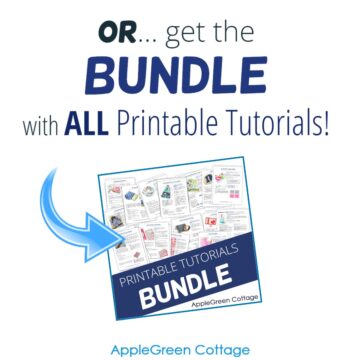
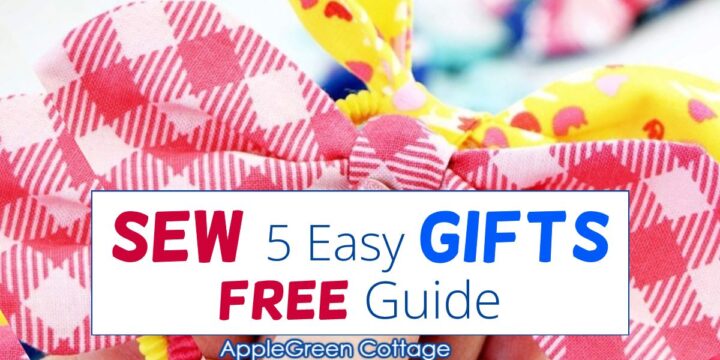
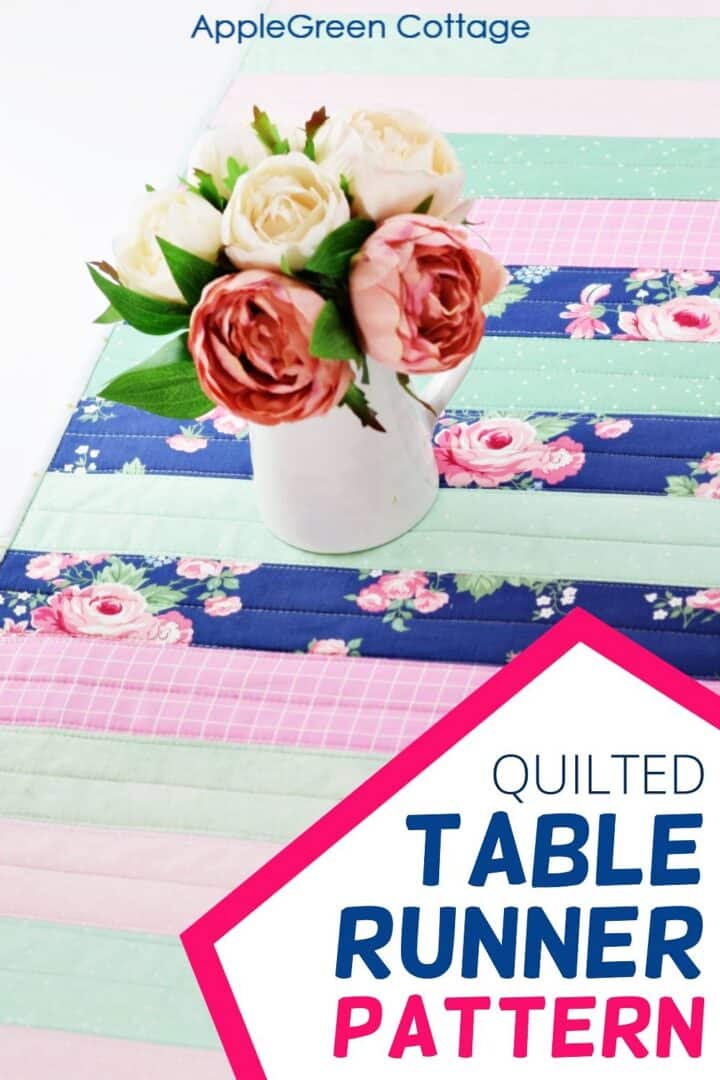
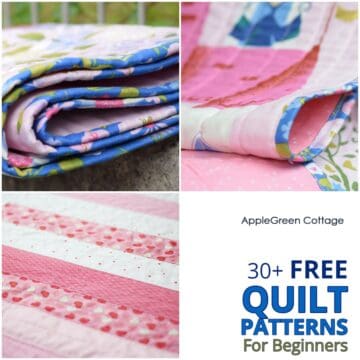
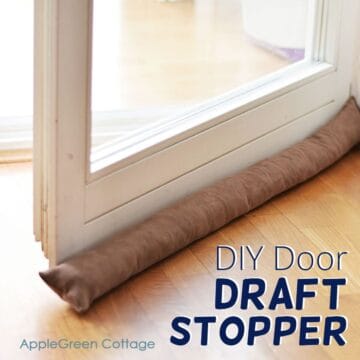
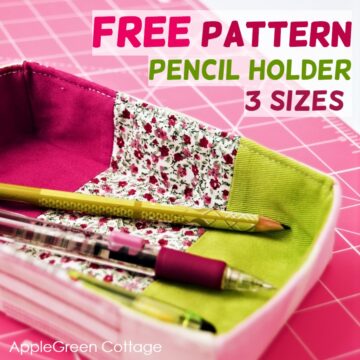
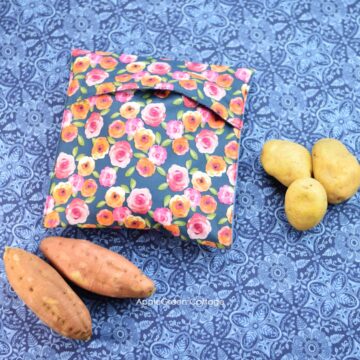
Annette Anderson
There appears to be a mistake in Step 6.2, where we begin laying down and sewing the strips together. The directions say to lay the first strip face down, then lay the second strip face down on top of it "(so the right sides of strips face each other)". I'm a literal person and laid the first strip face down with the second strip face down on top of it and sewed the right sides together. The left strip was face down. I "unsewed" it and am now resewing. If I'm wrong please let me know. But it would be good to update the directions. This my first QAYG. It's a pretty pattern.
Damjana
Annette hi, thank you, and you were right about the first strip - it is to be placed with the right side facing up. I've corrected the error, thanks. Damjana
Jill
I’m interested in making a wool table runner. Do you have any suggestions on how construction might differ from a cotton one? Also, what fabric would you recommend for backing?
Darla
Love your tutorials! The table runner made me think of something I’ve been searching for : a bed runner or bed scarf! Any chance you consider making a tutorial for that? Quilted or unquilted, pieced or not …
Thank you!
Damjana
Darla hi, a great idea! Adding to my list (currently at around 400-ish ideas to do for this site, so I admit it might take a while... 🙂